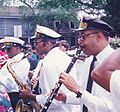Clarinet facts for kids
| Woodwind instrument | |
|---|---|
| Classification | Woodwind |
| Playing range | |
The clarinet is a popular woodwind instrument. It's known for its clear, rich sound and is used in many types of music, from classical orchestras to jazz bands and school bands.
The clarinet makes sound using a thin piece of bamboo or plastic called a reed. This reed is held onto the mouthpiece with a metal clamp called a ligature. When you blow air through the mouthpiece, the reed vibrates, creating the sound. The main part of the clarinet is a long tube with holes. Players cover these holes with their fingers or press keys that open and close pads over the holes. This changes the length of the air column inside, allowing the player to make different musical notes.
There are different types of clarinet key systems. Two main ones are the Albert system and the Boehm system. The Boehm system is very common, especially for classical and jazz musicians. In many Western countries, the most popular clarinet is the one pitched in B flat. This means if a clarinet player reads a note written as a C, it actually sounds like a B flat on a piano. This B flat clarinet is widely used in concert bands, marching bands, and school bands. Professional musicians also play other clarinets, like the A-clarinet (which sounds a bit lower) and the E flat clarinet (which sounds higher). The Bass_clarinet sounds much lower, like an octave below the B flat clarinet.
Many people find it quite easy to make a sound on the clarinet when they first try. This makes it a good instrument for young players, especially once their lower adult teeth have grown in. The way you use your fingers on the clarinet is similar to the flute and saxophone. So, if you learn the clarinet, it can be easier to learn those instruments later on.
A very famous piece of music that features the clarinet is Wolfgang Amadeus Mozart's Clarinet Concerto. Written in 1791, it's often considered one of the first great pieces written especially for the clarinet. In this concerto, the clarinet plays the main tune while the rest of the orchestra plays along.
Meet the Clarinet Family
The clarinet is part of a big family of instruments, with many different sizes and pitches. Some are quite rare, but here are some of the most important ones, from the highest-sounding to the lowest:
| Name | Key | What it's used for | |
|---|---|---|---|
| E♭ clarinet | E♭ | This clarinet has a bright, shrill sound. It's used in classical orchestras for special effects, and it's very common in concert bands. |  |
| C Clarinet | C | This clarinet was once very common but became less popular. Now, it's making a comeback in some music styles like Klezmer and in schools. |  |
| B♭ Clarinet | B♭ | This is the most common type of clarinet! When people say "clarinet," they usually mean this one. It was very popular in early jazz and swing with famous players like Benny Goodman. |  |
| 'A' Clarinet | A | This clarinet is often used in orchestras and chamber music, especially from the 1800s. Some people think it has a slightly softer sound than the B flat clarinet. |  |
| Basset clarinet | A | This is a special clarinet that can play even lower notes than a regular A clarinet. Mozart's famous Clarinet Concerto was originally written for this instrument. | |
| Basset-horn | F | This instrument looks a bit like an alto clarinet but is pitched in F and can play very low notes. Mozart also wrote music for the basset-horn. |  |
| Alto clarinet | E♭ or F | This clarinet is larger than the soprano clarinets and has a rich, dark sound. It's used in chamber music and concert bands. |  |
| Bass clarinet | B♭ or A | The bass clarinet is a very important part of modern orchestras and concert bands. It has a deep, resonant sound and is also used a lot in jazz. |  |
| E♭ contrabass clarinet | EE♭ | This is a very large clarinet, often used in clarinet choirs and concert bands to provide very low sounds. |  |
| Contrabass clarinet | BB♭ | This is one of the largest clarinets, playing the lowest notes in the family. It's used in clarinet choirs, concert bands, and sometimes in orchestras. |  |
Images for kids
See also
 In Spanish: Clarinete para niños
In Spanish: Clarinete para niños










